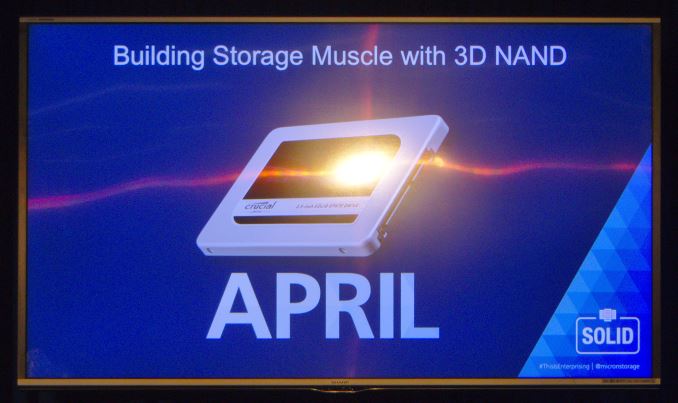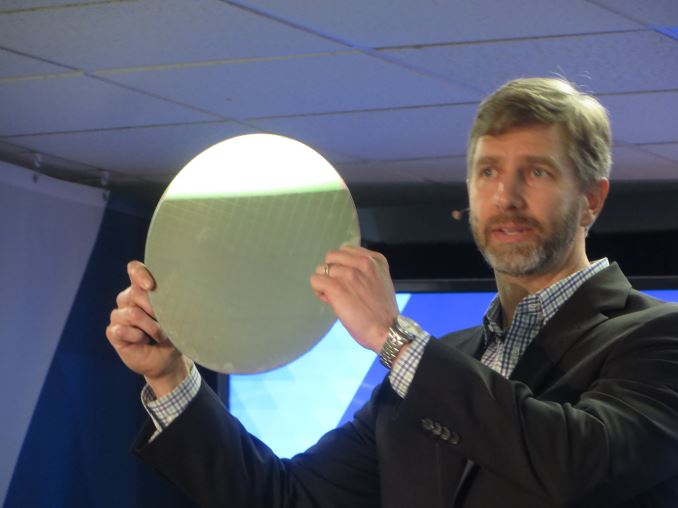Micron Presents New SSDs and Strategy: From Components to Whole Solutions, 3D NAND Shipping Imminent
by Billy Tallis on April 12, 2016 9:16 PM EST
At Micron's Enterprising event today in Austin, TX, the company discussed several upcoming products and shared information about an ongoing strategic shift. Not content to stay a mere component supplier for storage and memory, Micron is getting involved in software to help develop solutions that can make the most of their storage hardware offerings. The venue was Micron's new Storage Solutions Center, the nexus of Micron's collaboration efforts with OEMs, software vendors and enterprise end-users. At the Storage Solutions Center, Micron and their partners work on whole-system optimization to solve immediate customer needs and to generate reference architectures and documentation for the benefit of other customers.
The reference architectures are branded as Micron Accelerated Solutions, the first of which is a hardware platform by Supermicro bundled with VMWare Virtual SAN and using Micron M510DC SSDs. A similar solution has been developed with the Ceph object storage system and work is underway with Nexenta on an integrated system that will be available in the second half of the year.
In addition to the whole-system products, Micron shared information about several new and upcoming SSDs. The 9100 and 7100 series PCIe SSDs were launched and covered in a separate post. The 9100 was featured in a demo of the software defined storage system under development by SymbolicIO. The 7100 series is the second product line resulting from Micron's collaboration with Seagate, which previously resulted in a family of SAS SSDs.
Micron announced the schedule for their first 3D NAND SSDs. The Crucial MX300 will launch later this month using Micron's 3D TLC NAND. Specifics aren't available yet, but given the 384Gbit (48GB) capacity per die of the 3D TLC, the MX300 will either feature oddball capacities, significantly more overprovisioning than its MLC-based predecessors, or an uneven distribution of NAND dies across the controller's channels.
In June Micron will launch a pair of OEM client SSDs, the 1100 series and the 2100 series. Specifications for those drives were also not announced, but the photographs reveal some details: an M.2 SATA drive using a Marvell controller (probably 88SS1074, and thus probably also using TLC), and an M.2 PCIe drive with a Silicon Motion controller, presumably the SM2260.
Micron says there will be 3D NAND for the datacenter in the second half of the year, but they have not yet identified any of the drives that will be using it. A 3D XPoint wafer was waved around onstage but Micron made no substantial announcements today about the technology. They did promise that we'll be hearing more about the products and their branding later this year, and confirmed that they've been focusing on using 3D XPoint in NVMe products (whereas Intel is also developing NVDIMMs).
Source: Micron



















19 Comments
View All Comments
plopke - Tuesday, April 12, 2016 - link
Ha , guess that answers my questions about micron 3D NAND and XPoint products. So the person mentioning rumours of 3dNand and 3d Xpoint products of micron today was right :).My dreams of mainstream U.2 or NVMe adoption has to wait a bit longer i guess. Not a fan of some M.2 connectors squashed under graphics cards or a big expansion slot card. Still wondering if we will see more high-end geeky enthusiastic U.2 offerings one day.But a bit silly of me to think that , micron is mainstream/data-centres. Weird that we have PSU/Memory/CPU/motherboard/case/keyboard/mice/screen/.. enthusiastic brands but when it comes to storage it is OEM/consumer/DATA-centre , dull,boring,no risk but I do love those words when it comes to my storage :)!
On the other hand my dream of big SSD's .....!
plopke - Tuesday, April 12, 2016 - link
then again you only really can diversify with firmware unless making own controller.G0053 - Wednesday, April 13, 2016 - link
The hardest part of my new Skylake build was finding a motherboard with the features I needed and an M.2 connector ABOVE the top PCI-E slot. While also being affordable/cheap. I use a 980ti with an open air cooler and didn't want all that heat blowing strait on the M.2 drive.plopke - Wednesday, April 13, 2016 - link
Which one did you get in the end if I may ask? I might need myself a new one soon.zmatt00 - Thursday, April 14, 2016 - link
I had the same concern. There are a couple of Z170 boards that don't put the m.2 slot right between the video card and the processor. The one i chose has 2 m.2 slots, and the one i plan to fill with my 950 pro lies outboard from where the 980 ti will sit; this mobo is the Gigabyte z170x-gaming 7.mac_savant - Wednesday, April 13, 2016 - link
Kind of disappointed that the MX300 is going to switch over to TLC NAND, even if it is 3D. Was hoping the BX line would get the TLC and the MX would get MLC 3D NAND, similar to the Samsung 850 Pro and EVO.Hopefully the performance of the Micron 3D TLC NAND with have sufficient performance/durability that the MX300 will be a drive worth purchasing, but after the BX200 fiasco, I take nothing for granted.
bug77 - Wednesday, April 13, 2016 - link
IIRC, going 3D only improves durability. The performance stays about the same, because you still have to deal with several voltage levels.Then again, for typical home usage, I don't think 850 Pro is worth the price premium over a similar EVO drive. 850 Pro/950 Pro are options for whoever needs peak (sequential) performance, but I expect the vast majority of users is served very well by the EVO line.
MrCommunistGen - Wednesday, April 13, 2016 - link
Moving to smaller lithographies generally slows the NAND too. I can't seem to find the article which shows the different read/program/erase times across different lithographies but I'll try to find it later.Going to 3D in and of itself shouldn't have any effect on speed/durability, just density. This then allows them to move back up the scale from 1x nm to something in the 30-40 nm range. The larger lithography then reverses the read/program/erase slowing from moving to smaller lithographies and boosts endurance.
You're right though, TLC will remain inherently slower than MLC at similar manufacturing processes. I don't have the chart in front of me, but it is conceivable that at least for some operations ~40nm TLC might outperform 15/16nm MLC.
extide - Wednesday, April 13, 2016 - link
I would assume they will come out with a 3D MLC drive as well, possibly a bit later.Samus - Wednesday, April 13, 2016 - link
Yay to oddball capacities. 180 and 360gb for the price of current 120 and 240gb?I've always had a place in my heard for the Intel X25/SSD320's because of their weird sizes (160/300/600GB) because especially the 160GB version gave that extra few GB of space in office PC's where 120GB was pushing it after a bunch of apps, user profiles, temp files and hundreds of updates. Having to run a cleanmgr sage set in the monthly maintenance schedule wasn't necessary for the 160GB machines like it was for the 120GB machines.